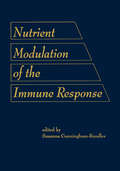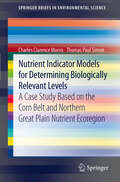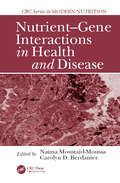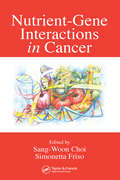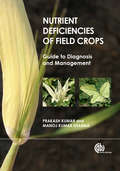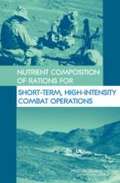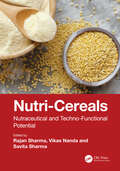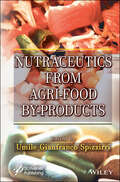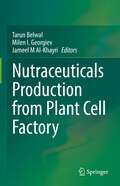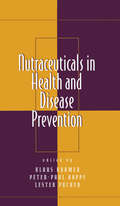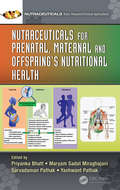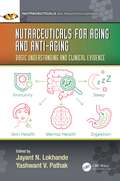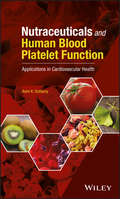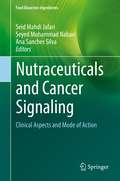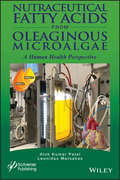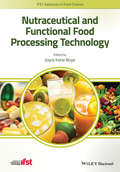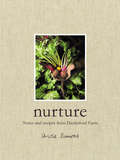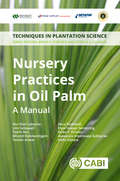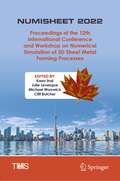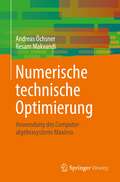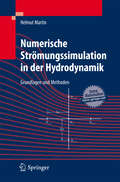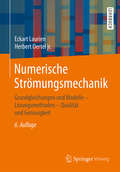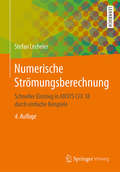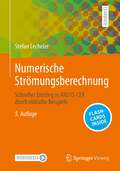- Table View
- List View
Nutrient Modulation of the Immune Response
by Susanna Cunningham-RundThis book demonstrates that nutrients play a direct role as co-factors and regulators of the immune system. The book also shows that modulating the immune response with nutrients can provide a fundamental approach to preventive medicine.;Containing nearly 2300 bibliographic citations as well as illustrative figures, tables, and micrographs, this book is designed to be of interest to clinical immunologists, immunology and vitamin researchers, nutrition specialists, paediatricians, neonatologists, and upper-level undergraduate, graduate, and medical school students in these disciplines.
Nutrient Indicator Models for Determining Biologically Relevant Levels
by Charles Clarence Morris Thomas Paul SimonNutrient Indicator Models for Determining Biologically Relevant Levels: A case study based on the Corn Belt and Northern Great Plain Nutrient Ecoregion is the first book to provide answers to the management of nutrients based on changes in biological communities. The text describes a case study that is the result of a large scale project in the Corn Belt and Great Plains Nutrient Ecoregion. This study is the first to identify relationships between fish assemblages and nutrient concentrations by Nitrogen species. Species optima based on sensitivity and tolerance to nutrients is modeled. Nutrient Biotic indices calibrated for application are based on the results of years of biological indicator development. Test response intervals and Shift response intervals are formulated and validated against relevant biological assemblage shifts. This case study is the first to suggest recommended values for the nitrogen and phosphorus cycle with identifiable shifts caused in biological assemblages. This will provide watershed and environmental managers with the information needed to manage the inputs into the world's dead zones.
Nutrient-Gene Interactions in Health and Disease
by Carolyn D. Berdanier Naima Moustaid-MoussaWe have come to realize that optimal nutrient intake is determined by very specific genetic messages. This realization has led to an entirely new approach to understanding nutrition - the exploration of nutrient effects on gene expression. Edited by leading experts in the field, Nutrient-Gene Interactions in Health and Disease provides an
Nutrient-Gene Interactions in Cancer
by Sang-Woon Choi Simonetta FrisoThe complete mapping of the human genome, along with the development of sophisticated molecular technologies, has accelerated research on the relationship between nutrients and genes. This has led to compelling evidence garnered from epidemiological and experimental observations supporting the idea that the interaction between nutrients and genes i
Nutrient Deficiencies of Field Crops: Guide to Diagnosis and Management
by Prakash Kumar Manoj Kumar SharmaNutrient imbalance in soils is an emerging threat to sustainable agriculture: intensive cultivation, use of poor quality groundwater, depletion of soil organic matter and excessive use of fertilizers are major reasons for poor soil fertility worldwide. This necessitates correct diagnosis of plant nutrient deficiencies to avoid further use of pesticides in cases where pests or pathogens that are not in fact the cause of poor crop health. Richly illustrated with 600 colour photographs, this book is a visual field identification guide for symptoms of most common nutrient deficiencies in field crops, covering all their stages of occurrence. Detailed descriptions and suggested for management practices are given with each entry.
Nutrient Deficiencies of Field Crops
by Manoj Kumar Sharma Prakash KumarNutrient imbalance in soils is an emerging threat to sustainable agriculture: intensive cultivation, use of poor quality groundwater, depletion of soil organic matter and excessive use of fertilizers are major reasons for poor soil fertility worldwide. This necessitates correct diagnosis of plant nutrient deficiencies to avoid further use of pesticides in cases where pests or pathogens that are not in fact the cause of poor crop health. Richly illustrated with 600 colour photographs, this book is a visual field identification guide for symptoms of most common nutrient deficiencies in field crops, covering all their stages of occurrence. Detailed descriptions and suggested for management practices are given with each entry.
Nutrient Composition Of Rations For Short-term, High-intensity Combat Operations
by National Research Council of the National AcademiesRecognizing the importance of good nutrition for physical and mental status, the Department of Defense asked the Institute of Medicine to guide the design of the nutritional composition of a ration for soldiers on short-term, high-stress missions. Nutrient Composition of Rations for Short-Term, High-Intensity Combat Operations considers military performance, health concerns, food intake, energy expenditure, physical exercise, and food technology issues. The success of military operations depends to a large extent on the physical and mental status of the individuals involved. Appropriate nutrition during assault missions is a continuous challenge mainly due to diminished appetites of individuals under stress. Many less controllable and unpredictable factors, such as individual preferences and climate, come into play to reduce appetite. In fact, soldiers usually consume about half of the calories needed, leaving them in a state called “negative energy balance.” The consequences of being in negative energy balance while under these circumstances range from weight loss to fatigue to mental impairments. An individual’s physiological and nutritional status can markedly affect one’s ability to maximize performance during missions and may compromise effectiveness. With the number of these missions increasing, the optimization of rations has become a high priority.
Nutri-Cereals: Nutraceutical and Techno-Functional Potential
by Rajan Sharma Vikas Nanda Savita SharmaThe term "Nutri-Cereals" has been dedicated to ten cereals due to their unique nutritional benefits. Nutri-Cereals: Nutraceutical and Techno-Functional Potential covers these cereal grains, with each chapter focusing on nutrient composition and bioactive characterization followed by associated bio-functional properties and health benefits. Further, it covers techno-functionality of nutri-cereals including rheological properties, emulsification and foaming potential, gelation behavior, color profile and others which dictate the suitability of cereals in finished products. Key Features: Covers diverse biological and functional features of nutri-cereals to dictate their potential as functional ingredients in value-added products. Discusses the nutraceutical potential of ten cereals: sorghum, pearl millet, finger millet, foxtail millet, barnyard millet, kodo millet, little millet, proso millet, black wheat and Amaranthus. Explains how these grains are ideal ingredients for gluten free food formulations with enhanced bio- and techno-functional characteristics. Although many of the nutri-cereals have been known for thousands of years, due to their coarse nature and lack of processing they escaped the human diet. Now, thanks to their excellent agro-economic potential and numerous health benefits, they are once again recognized as functional ingredients. Recently, earmarked investment and funding have been observed for valorization of these crops and thus, this book will help academicians to strengthen future investigations.
Nutraceutics from Agri-Food By-Products
by Umile Gianfranco SpizzirriNUTRACEUTICS FROM AGRI-FOOD BY-PRODUCTS This book represents a comprehensive and unique overview covering different aspects (raw materials, technological innovations, and potential applications) concerning waste and by-products of the food industry. Wastes and by-products of the agri-food chain represent a rich source of active molecules that can be usefully employed in the food and pharmaceutical industries. Eco-friendly extraction procedures able to isolate the different components of the agri-food by-products represent an attractive challenge to increase the waste’s value, and, at the same time, solve the issues usually related to their disposal. Each of the 12 chapters in Nutraceutics from Agri-Food By-Products deeply analyses a specific agri-food chain, highlighting the main components recovered in the processing of food, seafood, and dairy wastes and by-products. Specifically, a green approach to the extraction of active molecules is described, as well as the industrial application of agri-food wastes and by-products, and their chemical, physical, and biological properties. Such properties are suitable for use in the food, cosmetic, and pharmaceutical fields. This circular approach could be usefully employed in the industry to develop and commercialize new nutraceuticals and/or functional food that guarantee a considerable increase in the economic worth of the wastes, while producing beneficial effects on human health. Audience Food technologists and biotechnologists in research and industry as well as researchers in pharmaceutical sciences.
Nutraceuticals Production from Plant Cell Factory
by Tarun Belwal Milen I. Georgiev Jameel M Al-KhayriThis book focuses on in vitro techniques and challenges of producing nutraceutical compounds from plant cells. In addition, it provides an overview of different biosynthesis pathways and their modulation through cell culture techniques for the production of nutraceutical compounds in high quantity and quality. It also includes the assessment of the factors influencing production and advances in cell culture techniques, including the scale-up approach using bioreactors. Lastly it provides valuable suggestion for future research.
Nutraceuticals in Health and Disease Prevention
by Lester Packer Klaus KrÄmer Peter-Paul HoppePromoting scientific support for the plethora of health benefits related to nutrition and medicine, Nutraceuticals in Health and Disease Prevention delivers a comprehensive and scientifically sound overview of the latest research findings in disease prevention, therapy, and enhanced body function in the revolutionary field of nutraceutical technolo
Nutraceuticals for Prenatal, Maternal, and Offspring’s Nutritional Health (Nutraceuticals)
by Priyanka Bhatt Maryam Sadat Miraghajani Sarvadaman Pathak Yashwant PathakAlthough there is an increasing number of pregnant individuals taking nutraceuticals to maintain good health, many gaps exist in the knowledge base. These nutraceuticals might be involved in a wide variety of biological processes, and the biological and epidemiological findings of relevant studies should be examined and analyzed. Nutraceuticals for Prenatal, Maternal and Offspring’s Nutritional Health focuses on the role of nutraceuticals for prenatal, mothers, and offspring’s health. In recent years, new trends have been established in this area of prenatal nutrition, that is, mother and offspring health based on appropriate nutrition during pre-pregnancy, pregnancy, and after pregnancy. Nutraceuticals and natural products have been used by many cultures and societies around the world. This book focuses on recent trends and potential clinical evaluations of such nutraceuticals and natural products. Features: Examines the role of Nutraceuticals on the mothers and offspring’s disease and health Focuses on human population-based research Discuses role of nutraceuticals in placental development, nutraceuticals for gestational weight pain and post-partum obesity Covers nutraceuticals impacting uterine growth, gestational age, and mortality rate Explores the question whether Nutraceuticals intake in pregnant women is safe as they might be involved a wide variety of biological processes With 19 chapters written by established lead authors in this field, Nutraceuticals for Prenatal, Maternal and Offspring’s Nutritional Health addresses important findings of the latest scientific research regarding the role of nutraceuticals intake before and during pregnancy.
Nutraceuticals for Aging and Anti-Aging: Basic Understanding and Clinical Evidence (Nutraceuticals)
by Jayant Nemchand LokhandeAging can be perceived differently during different times in one’s life. Aging as a process not only influences medical and economic dimensions at an individual level but also at societal and national levels. Aging is a natural process; however, its standard definition in a healthcare context is yet unclear. To delay the aging process and to maintain quality of life until the end of life are two goals of prime importance. Various healthcare approaches are being developed and experimented on to best manage aging as if it is a disease. Nutraceuticals are value-added dietary supplement products and have an immense potential in altering key structures and functions of aging. Nutraceuticals can be a keystone in altering sub-normal performing physiological and metabolic systems due to aging. Nutraceuticals for Aging and Anti-Aging: Basic Understanding and Clinical Evidence addresses aging and anti-aging nutraceuticals based on 10 major challenges, such as cognitive health, malnutrition, substance abuse, bladder control, and oral health, among others. It examines how these challenges can be complemented with nutraceuticals and connects the applications with the traditional wisdom of the aging process. Key Features Examines the aging process, then recommends nutraceuticals for aging and anti-aging processes Describes the aging process from the western perspective, and Ayurvedic medicine (Indian traditional system) and traditional Chinese medicine perspectives Provides, whenever possible, the clinical evidence of the applications of nutraceuticals for aging and anti-aging This book is a valuable resource for physicians, clinical experts, pharmaceutical companies and their experts, nutrition specialists, entrepreneurs, chemists, pharmacists, food chemists-technologists, as well as researchers and post-graduate students involved in these specialties.Also available in the Nutraceuticals: Basic Research/Clinical Applications Series:Bioactive Peptides: Production, Bioavailability, Health Potential, and Regulatory Issues, edited by John O. Onuh, M. Selvamuthukumaran, and Yashwant V. Pathak (ISBN: 978-0-3675-1177-7)Nutraceuticals for Prenatal, Maternal and Offspring’s Nutritional Health, edited by Priyanka Bhatt, Maryam Sadat Miraghajani, Sarvadaman Pathak, and Yashwant V. Pathak (ISBN 978-1-1383-4582-9)Advances in Nutraceutical Applications in Cancer: Recent Research Trends and Clinical Applications, edited by Sheeba Varghese Gupta, and Yashwant V. Pathak (ISBN 978-1-1385-9391-6)
Nutraceuticals and Human Blood Platelet Function: Applications in Cardiovascular Health
by Asim K. DuttaroyA comprehensive review of the impact of dietary nutraceuticals on platelet function and its relationship to cardiovascular disease Nutraceuticals and Human Blood Platelet Function offers a summary of the most current evidence on the effects of anti-platelet factors isolated mainly from food and natural sources, their structure function relationship, bioavailability, mechanisms of actions, and also information on human trials data. The author—a noted expert in the field— explores platelet function and their roles in development of CVD, functional foods and bioactive compounds in CVD risk factors. The author highlights platelets, their mechanisms of actions, data from epidemiological studies, structure-function relationship clinical trial data, ex vivo and in vitro data. This important resource will focus primarily on human studies and emphasize functional and physiological implications of the nutritional impact on platelet function and CVD that could be an important approach to highlight the concept of preventive CVD nutrition. An authoritative text, Nutraceuticals and Human Blood Platelet Function: Offers a unique resource that connects nutrition with platelet function and its impact on cardiovascular disease Contains an evidenced-based approach, including data from human and animal clinical studies Reveals the impact of bioactive compounds and their effect on platelets Presents a text that is authored by an expert with vast experience in the field of nutrition and platelet function Written for professionals, academics, researchers, and students associated in the area of nutrition, Nutraceuticals and Human Blood Platelet Function offers a review of the most current research on the effects of platelet function and their roles in development of CVD, functional foods and bioactive compounds in CVD risk factors.
Nutraceuticals and Cancer Signaling: Clinical Aspects and Mode of Action (Food Bioactive Ingredients)
by Seid Mahdi Jafari Seyed Mohammad Nabavi Ana Sanches SilvaToday's consumers are looking for food products with health-promoting roles in addition to nutritional benefits. With current research showing that nutraceuticals and functional foods rich in specific bioactives may have chemopreventative effects, these products are increasingly popular. However, while much in the literature supports the health-promoting features of these foods, few texts focus on their bioactive agents and their mode of action in cancer signaling. Nutraceuticals and Cancer Signalling: Clinical Aspects and Mode of Action explains the link between nutraceuticals and cancer in terms of clinical trials and modes of action. This book gives an overview of common cancers and their mechanisms, and the most common functional foods and their bioactive components. Individual chapters focus on specific functional foods--including tomatoes, garlic, honey, tea, yoghurt, and many more--their prominent bioactive compounds, and their mode of action in cancer signaling and chemoprevention. Recent findings on cancer-prevention roles of different vitamins and minerals are also discussed. For food scientists, nutritionists, and pharmaceutical experts looking to understand how functional foods can play a role in fighting cancer, this text serves as a one-stop reference.
Nutraceutical Fatty Acids from Oleaginous Microalgae: A Human Health Perspective
by Alok Kumar Patel Leonidas MatsakasOver the past several years, extensive research has been done on the microbial production of polyunsaturated fatty acids (PUFA). Regardless, research on the oleaginous microalgae used as feedstock for biofuels production and the overall story about the production of nutraceutical fatty acids from oleaginous microalgae has been very limited. This volume provides an exclusive insight on the production of nutraceutical fatty acids from oleaginous microalgae and their role on human health. Some saturated and monounsaturated fatty acids can be synthesized by humans, whereas long-chain polyunsaturated fatty acids (PUFAs) such as α-linolenic acid and linoleic acid cannot and are deemed essential. The products of these acids, such as DHA, which is important for early visual and neurological development, are extremely important to human health. Replacing SFAs with omega-3 and omega-6 fatty acids in the diet reduce the risk of cardiovascular diseases and prevent Alzheimer's, bipolar disorder, and schizophrenia, among other benefits. The ever-rising global demand for omega-3 & 6 PUFAs, however, cannot be met solely by fish oil, due to diminishing fish stocks and pollution of marine ecosystems, which has led to increased interest in alternative sustainable sources. Vegetable oils from genetically engineered plant oilseeds and microorganisms are two potential alternatives to fish oil, even though omega-3 PUFAs are highest in the latter. Although transgenic plants present numerous advantages, their production is dependent on seasonal and climatic conditions and the availability of arable land. Moreover, there are public concerns regarding the cultivation of transgenic crops in open ecosystems. These, together with regulatory issues restrict the large-scale production of genetically modified crops. Microorganisms, however, are known natural producers of microbial oils similar to those obtained from plants and animals and a possible source of nutritionally important omega-3 & 6 PUFAs. This groundbreaking volume presents invaluable new research on essential fatty acids, their production from various oleaginous microorganisms, biochemical and metabolic engineering to improve PUFAs content in oil, extraction and purification of omega 3 fatty acids, and the current market scenario. Whether a veteran engineer or scientist using it as a reference or a professor using it as a textbook, this outstanding new volume is a must-have for any engineer or scientist working in food science.
Nutraceutical and Functional Food Processing Technology (IFST Advances in Food Science)
by Joyce I. BoyeFor several years, the food industry has been interested in identifying components in foods which have health benefits to be used in the development of functional food and nutraceutical products. Examples of these ingredients include fibre, phytosterols, peptides, proteins, isoflavones, saponins, phytic acid, probiotics, prebiotics and functional enzymes. Although much progress has been made in the identification, extraction and characterisation of these ingredients, there remains a need for ready and near-market platform technologies for processing these ingredients into marketable value-added functional food and nutraceutical products. This book looks at how these ingredients can be effectively incorporated into food systems for market, and provides practical guidelines on how challenges in specific food sectors (such as health claims and marketing) can be addressed during processing. Nutraceutical and Functional Food Processing Technology is a comprehensive overview of current and emerging trends in the formulation and manufacture of nutraceutical and functional food products. It highlights the distinctions between foods falling into the nutraceutical and functional food categories. Topics include sustainable and environmentally–friendly approaches to the production of health foods, guidelines and regulations, and methods for assessing safety and quality of nutraceutical and functional food products. Specific applications of nutraceuticals in emulsion and salad dressing food products, beverages and soft drinks, baked goods, cereals and extruded products, fermented food products are covered, as are novel food proteins and peptides, and methods for encapsulated nutraceutical ingredients and packaging. The impact of processing on the bioactivity of nutraceutical ingredients, allergen management and the processing of allergen-free foods, health claims and nutraceutical food product commercialization are also discussed. Nutraceutical and Functional Food Processing Technology is a comprehensive source of practical approaches that can be used to innovate in the nutraceutical and health food sectors. Fully up-to-date and relevant across various food sectors, the book will benefit both academia and industry personnel working in the health food and food processing sectors.
Nursery Practices in Oil Palm: A Manual (Techniques In Plantation Science Ser. #17)
by Brian Forster Umi Setiawati Fazrin Nur Miranti Rahmaningsih Yassier Anwar Nur D Laksono Heru Rusfiandi Eben Haeser Sembiring Avasarala Sreenivasa Subbarao Hafni ZaharaThis is a hands-on, practical guide to general and specific practices in oil palm nurseries to produce healthy, vigorous and uniform plants ready for field planting. There are two nursery stages, pre-nursery and main nursery. The pre-nursery receives both germinated seeds and tissue culture produced plantlets (ramets) which are planted in a relatively small area in which shade and humidity can be controlled. Once young plants are established they are transferred to the main nursery, potted-on and grown on to produce field-ready plants. Good nursery practices, using sustainable approaches where possible, aim to provide high quality planting materials for both commercial production and field trialling. The book covers: Nursery set up - pre-nursery and main nursery Fertilizer programmes Watering Culling Weeding Pests and diseases Pre-field genotypic screening and selection Quarantine nurseries This is an invaluable manual for commercial seed producers, nursery plant producers, commercial plantation companies and plant breeders, as well as researchers in oil palm. It is useful for those starting a career in oil palm production, and as a reference guide for managers and for training purposes.
NUMISHEET 2022: Proceedings of the 12th International Conference and Workshop on Numerical Simulation of 3D Sheet Metal Forming Processes (The Minerals, Metals & Materials Series)
by Kaan Inal Julie Levesque Michael Worswick Cliff ButcherThe NUMISHEET conference series is the most significant international conference on the area of the numerical simulation of sheet metal forming processes. It gathers the most prominent experts in numerical methods in sheet forming processes and is an outstanding forum for the exchange of ideas and for the discussion of technologies related to sheet metal forming processes. Topics covered in this volume include but are not limited to the following: Materials Modeling and Experimental Testing MethodsFriction and ContactFormability, Necking, and FractureInstabilities and Surface DefectsFracture and DamageNumerical MethodsSpringbackIncremental Sheet FormingRoll FormingInnovative Forming MethodsProduct and Process Design and Optimization
Numerische technische Optimierung: Anwendung des Computeralgebrasystems Maxima
by Andreas Öchsner Resam MakvandiDiese Studienhilfe zu numerischen Optimierungsverfahren richtet sich an Studierende des Maschinenbaus im Grundstudium und im Hauptstudium. Optimierungsverfahren gewinnen zunehmend an Bedeutung für den Leichtbau, wo eine Gewichtsreduzierung z.B. im Automobilbau oder in der Luft- und Raumfahrtindustrie zu einem geringeren Kraftstoffverbrauch und einer entsprechenden Senkung der Betriebskosten sowie zu positiven Auswirkungen auf die Umwelt führen kann. Basierend auf dem freien Computeralgebrasystem Maxima stellen die Autoren Verfahren zur numerischen Lösung ingenieurmathematischer Probleme sowie Anwendungen aus traditionellen Lehrveranstaltungen zur Festigkeit von Werkstoffen vor. Die mechanischen Theorien konzentrieren sich auf die typischen eindimensionalen Strukturelemente, d.h. Federn, Stäbe und Euler-Bernoulli-Balken, um die Komplexität des numerischen Rahmens zu reduzieren und den resultierenden Entwurf auf eine geringe Anzahl von Variablen zu beschränken. Die Verwendung eines Computeralgebrasystems und der darin enthaltenen Funktionen, z. B. für Ableitungen oder Gleichungslösungen, ermöglicht eine stärkere Konzentration auf die Methodik der Optimierungsverfahren und nicht auf Standardverfahren.Das Buch enthält auch zahlreiche Beispiele, darunter einige, die mit Hilfe eines grafischen Ansatzes gelöst werden können, um dem Leser ein besseres Verständnis der Computerimplementierung zu vermitteln.
Numerische Strömungssimulation in der Hydrodynamik
by Helmut MartinDer Band liefert eine Einführung in die numerische Strömungssimulation im Bau- und Wasserwesen. Nach einem Überblick über die Methoden werden in Teil 1 Grundlagen und Grundgleichungen der Strömungsmechanik formuliert. In Teil 2 werden ausgewählte Methoden wie die Finite-Element-Methode, das Galerkin-Verfahren, die Finite-Volumen- und Finite-Element-Methode anhand von Beispielen aus der Hydrodynamik erläutert. Vier Programme, mit denen Beispiele im Buch bearbeitet werden können, stehen Lesern unter http://extras.springer.com zur Verfügung.
Numerische Strömungsmechanik: Grundgleichungen und Modelle ‒ Lösungsmethoden ‒ Qualität und Genauigkeit
by Herbert Oertel jr. Eckart LaurienDieses Lehrbuch behandelt ergänzend zu den Grundlagenwerken der Strömungsmechanik die praktische Anwendung numerischer Methoden in Industrieprojekten. Es werden zunächst die Grundgleichungen der Strömungsmechanik wiederholt und für die Lösung mit numerischen Algorithmen aufgearbeitet. Die Diskretisierung des Strömungsfeldes einschließlich der Netz-Generierung sowie ausgewählte Lösungsverfahren der Finite-Differenzen-, Finite-Volumen und Finite-Elemente-Methoden werden dargestellt. Die Anwendung strömungsmechanischer Software für die Lösung von Industrieproblemen der Kraftfahrzeug-, Energie- und Umwelttechnik, Luft- und Raumfahrt sowie Bio- und Medizintechnik werden eingehend behandelt. In der aktuellen Auflage helfen nachhaltig neue illustrierende Beispiele aus verschiedenen Bereichen der Technik. Bilder und Tabellen wurden zwecks besserem Verständnis neu gestaltet sowie das Literaturverzeichnis erweitert.
Numerische Strömungsberechnung: Schneller Einstieg in ANSYS CFX 18 durch einfache Beispiele
by Stefan LechelerDieses Lehr- und Übungsbuch richtet sich an zukünftige Anwender von Berechnungssoftware zur Strömungsmechanik. Neben den verständlich dargestellten Grundlagen liegt der Schwerpunkt auf ausführlich behandelten technischen Beispielen mit ergänzenden praktischen Hinweisen. Verständnisfragen inklusive Antworten geben dem Einsteiger Sicherheit für grundlegende Zusammenhänge. Die 4. Auflage wurde an die neueste Programmversion ANSYS 18.1 angepasst
Numerische Strömungsberechnung: Schneller Einstieg in ANSYS-CFX durch einfache Beispiele
by Stefan LechelerDieses Lehr- und Übungsbuch bietet allen einen Leitfaden, die Berechnungsprogramme zur Strömungsmechanik einsetzen möchten. Nach der gut verständlichen Abbildung der Grundlagen werden im Besonderen technische Beispiele detailliert behandelt und mit praktischen Hinweisen ergänzt. Um Neueinsteigenden Sicherheit bei den grundlegenden Zusammenhängen zu vermitteln, helfen Verständnisfragen inklusive Anwendungen. Die 5. Auflage wurde an die aktuelle Ansys-Programmversion angepasst. Testen Sie Ihr Wissen mit Fragen und Antworten zum Buch in der Springer Nature Flashcards-App.
